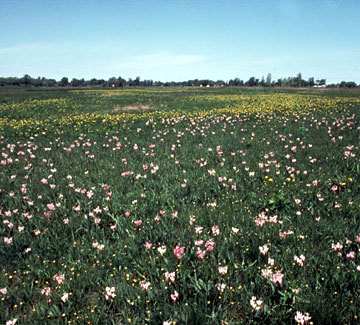
Piping plover
By Morgan Linn
The Chiwaukee Illinois Beach Lake Plain is one special wetland.
It encompasses 15 miles of Lake Michigan coast in Wisconsin and Illinois and is “known for its spectacular wildflowers, with spring, fall and summer each offering a different suite of colors and textures,” says the Wisconsin Wetlands Association (WWA).
It is home to lots of rare plants and
animals and diverse wetland types. It “provides a habitat for over 400 prairie plant species, and … provides just wonderful places for birds, amphibians, reptiles, and insects,” said Steve Richter, the director of conservation programs for the Wisconsin chapter of the Nature
Conservancy.
It has survived being surrounded by urban development, and contains some of the last areas of natural vegetation in the Lake Plain system, he said.
And now it’s been added to the List of Wetlands of International Importance by the Ramsar Convention.
That group consists of “well over 150 countries across the globe [that] meet every few years to work on wetland conservation,” said Richter.

The dots show Ramsar site locations and the star where the Chiwaukee Illinois Beach Lake Plain is located. Click for interactive map. Image: Ramsar
Lake Plain is the ninth wetland in a Great Lakes state to get the recognition. Five more in Ontario also lie in the Great Lakes basin.
Such wetlands — also known as Ramsar sites – are designated as internationally important.
Conservation organizations and local communities petitioned for the designation of Lake Plain as a Ramsar site, said Richter. Some of those groups have protected the wetland for more than 50 years.
A site must also have political support to be designated, said Bill Mitsch, the chair of the U.S. National Ramsar Committee. The groups secured about 20 letters of support and the approval of the U.S. Fish and Wildlife Service.
The United States had to nominate the wetland to the Convention. To gain the title, it had to meet at least one of nine criteria. The Lake Plain meets three:
-
It contains six rare types of wetland, according to the site fact sheet. It has a mixture of ridges and swales, formed by a drop in Lake Michigan’s water level, Richter said. The ridges provide a dry and sandy prairie habitat, while the swales provide wetland habitat.
-

Fringed Orchid. Image: Joshua Mayer on flickr
It supports species dependent upon wetlands. It provides a habitat for more than 26 rare plant species, such as the endangered piping plover, and is the only part of the region where the eastern prairie fringed orchid thrives. It is also home to the largest population of Blanding’s turtle, which is threatened in Illinois. -
It supports plants and animals during critical stages of their lives, such as migration or breeding. “Its location along Lake Michigan provides a stopover habitat for migrating birds and monarch butterflies as they travel from their nesting grounds,” Richter said. The Lake Plain is a crucial area where these species “can refuel, energize back up, be safe from predators and then continue this journey on migration.”
The United States has 38 Ramsar sites. That isn’t many for the size of the country, Mitsch said. Denmark is only the size of Ohio, but has around 50 sites.
The nine sites in Great Lakes states and the five in Ontario and the year they were designated:
Wisconsin
- Horicon Marsh (1990)
- Kakagon and Bad River Sloughs (2012)
- Door Peninsula Coastal Wetlands (2014)
Illinois
- The Cache River-Cypress Creek Wetlands (1994)
- The Sue and Wes Dixon Waterfowl Refuge at Hennepin & Hopper Lakes (2012)
- The Emiquon Complex (2012)
Ohio
- Wilma H. Schiermeier Olentangy River Wetland Research Park (2008)
Michigan
- Humbug Marsh (2010)
Wisconsin, Illinois and Minnesota
- Upper Mississippi River Floodplain Wetlands (2010)
Ontario
- Long Point (1982)
- St. Clair (1985)
- Point Pelee (1987)
- Matchedash Bay Provincial Wildlife Area (1996)
- Minesing Swamp (1996)
A map of all Ramsar sites is here.
The Lake Plain faces threats such as “invasive plant species, urban development and conversion of grasslands and woodlands in the surrounding areas for agriculture,” according to the fact sheet.
Granting wetlands international importance helps protect them from such dangers. There are three main “pillars” that parties of the Convention must adhere to, to ensure that wetlands are preserved.
They include working toward their wise use, properly managing them and cooperating when they are shared by multiple jurisdictions.
Ramsar has no legal authority; the requirements are not binding, Mitsch said. However the designation adds some protection because of international recognition.
“The most important thing it gives you is international prestige,” he said.
Mitsch aims to have at least 150 Ramsar sites in the U.S. and hopes to eventually get every single state involved in promoting the nomination of wetlands.
